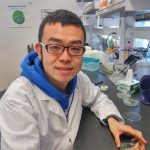Dr. Ljerka Kunst, Professor
I grew up in Zagreb, Croatia, and I completed my BSc degree in Biology (1981) and MSc in Cell Biology (1982) at the University of Zagreb. For my BSc honours research and MSc I studied plastid development and differentiation which sparked my interest in plastids and photosynthesis, and led me to pursue a PhD in Botany (1988) at Michigan State University under the supervision of Chris Somerville. My PhD project exposed me to plant lipid research and Arabidopsis genetics as a tool to address biological questions. I have been using the Arabidopsis mutants ever since to dissect floral developmental patterning as a Postdoctoral Fellow at the University of Saskatchewan (1988-89), seed fatty acid elongation as a Research associate (1989-91) and Research officer at the NRCC Plant Biotechnology Institute, Saskatoon (1991-93), as well as to study seed oil and plant surface lipid biosynthesis once I got a “real job” and was appointed Assistant Professor in the Department of Botany at UBC (1993).
Having been trained as a cell biologist, geneticist and molecular biologist, I like to employ a variety of approaches to investigate basic and applied questions in plant lipid metabolism.
Lifang Zhao, Postdoc

I obtained my B.Sc. degree in Biotechnology from Nankai University in China and joined the Kunst lab in September of 2006. As a M.Sc. student, I investigated the contributions of long-chain acyl-CoA synthetase (LACS) family, especially LACS8, LACS9 and LACS1, to seed oil production in Arabidopsis. After finishing my M.Sc. project in 2009, I decided to stay in the Kunst lab for my Ph.D., but switched from seed storage lipid to stem surface lipid research. By identifying and analyzing the suppressors of the cer7 mutant, I discovered that SUPERKILLER proteins and small RNAs are both involved in the regulation of cuticular wax production on Arabidopsis stems. After obtaining my Ph.D. in April 2015, I’ve been working as a post-doctoral fellow exploring how wax is delivered to the plasma membrane in Arabidopsis. I’m also interested in identifying proteins that are involved in the biosynthesis of cuticular waxes in early land plants like the moss Physcomitrella patens.
Tegan Haslam, PhD student
I received my BSc in Botany from the University of Calgary in 2009. During the final year of my undergraduate degree, I completed an Honours Thesis under the supervision of Dr. Dae-Kyun Ro. I investigated the biosynthesis and transcriptional regulation of a novel sesquiterpenoid phytoalexin from lettuce, lettucenin A. This experience sparked my interest in plant metabolism, which I developed further post-graduation working as a technician in Dr. Ro’s lab on a Canada-wide transcriptome sequencing project.
I am fascinated by the diversity of chemicals that plants produce, and how this contributes to fitness. The plant cuticle is an excellent example of specialized metabolism fulfilling a need in plant survival. Cuticular waxes are found on the aerial surfaces of all land plants, where they play a critical role as a barrier restricting water loss, protecting the plant from abiotic stresses, and serve as an interface for many plant-pathogen and plant-insect interactions. Cuticular waxes consist predominantly of derivatized very-long-chain fatty acids (VLCFAs) 24-36 carbons in length. The elongation of VLCFAs has been thoroughly investigated, and is now known to be catalyzed by a heterotetrameric fatty acid elongase (FAE) complex. However, it has been a mystery for some time how wax monomers longer than 28 carbons are produced, as characterized plant FAE components do not appear to be able to elongate VLCFAs efficiently past this threshold length. This is not trivial, as the bulk of wax monomers are 29-33 carbons in many plant species.
For my PhD, I am investigating this intricacy in VLCFA elongation using molecular genetics and biochemistry in Dr. Ljerka Kunst’s lab at the University of British Columbia. I’ve found that CER2, a gene previously identified in a screen for wax-deficient mutants, plays a critical function in VLCFA elongation past 28 carbons. I have demonstrated this through analysis of the cer2 mutant phenotype and heterologous reconstitution of elongation past 28 carbons in the yeast Saccharomyces cerevisiae. My ongoing research involves dissection of how this process occurs at the biochemical level, and establishing the importance of CER2 function in the evolution of lipid metabolism.
Shuang (Joyce) Liu, PhD student
I completed my B.Sc. in Plant Science in 2009 at the China Agricultural University and My M.Sc. in Genetics in 2012 at Fudan University. For my M.Sc. research, I studied genes that control the flowering time in rice. I joined the Kunst lab and started my Ph.D. in the Botany Department at UBC in January, 2013. For my Ph.D., I am interested in studying the regulation of cuticular wax biosynthesis in Arabidopsis using molecular and genetic techniques. I am working on several wax-deficient mutants and I am trying to elucidate biochemical functions of proteins that are affected in these lines, and investigate their roles in wax deposition.
Mingzhe (Alex) Liu, PhD student

I got my Bachelor’s Degree of Agronomy in 2014 at Northwest A & F University in China. I continued my research at the same university focusing on plant lipid metabolism and obtained my Master’s Degree in 2016. My Master’s thesis mainly involved investigation of genes that control seed oil accumulation in a model plant Arabidopsis. Therefore, I believe that joining the Haughn & Kunst lab for my Ph.D. is a perfect fit for me.
For my Ph.D. research, I am interested in cloning and functional analysis of genes which may influence both seed lipid metabolism and seed coat development using molecular and genetic techniques. I am currently working on several Arabidopsis lines which exhibit changes in seed oil content compared with wildtype Arabidopsis and trying to find out the underlying cause of their oil variation.
Zhuowei (Charles) Li, PhD student

I received my B.Sc. in Plant Science in 2013 and M.Sc. in Corps Genetics and Breeding in 2016 at the Northwest A&F University in China. My Masters project focused on the regulation of seed storage oil production and the synthesis of VLCFAs which are the precursors of cuticular wax.
I started my Ph.D. in the Kunst lab in September of 2016. I am now interested in the biosynthesis and secretion of cuticular wax. The overall aim of my research is the investigation of wax biosynthesis in Physcomitrella patens to understand the formation of early land plant cuticles and their role in plant resistance to pathogens and abiotic stress.


